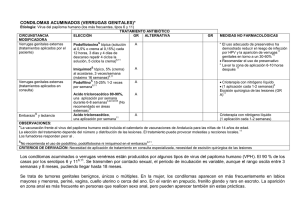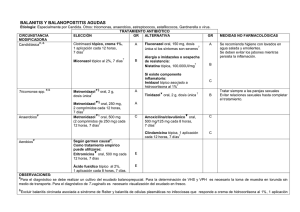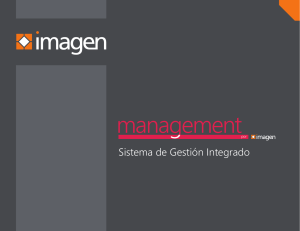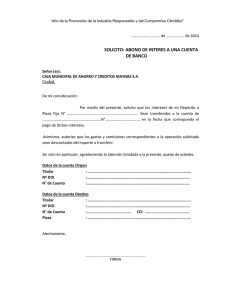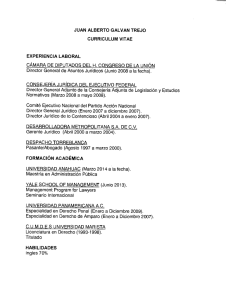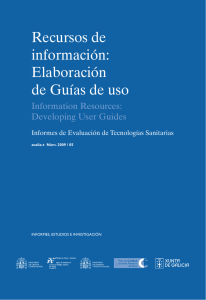LINFOGRANULOMA VENEREO Etiología: Chlamydia trachomatis
Anuncio
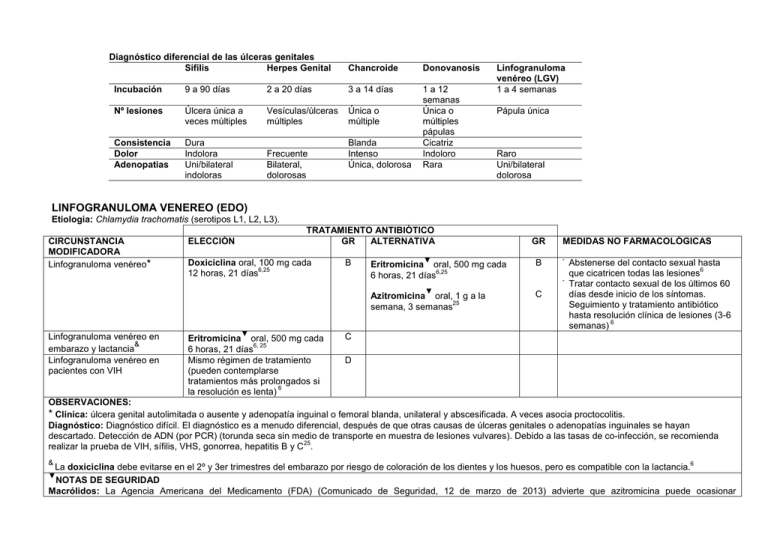
Diagnóstico diferencial de las úlceras genitales Sífilis Herpes Genital Chancroide Donovanosis 1 a 12 semanas Única o múltiples pápulas Cicatriz Indoloro Rara Incubación 9 a 90 días 2 a 20 días 3 a 14 días Nº lesiones Úlcera única a veces múltiples Vesículas/úlceras múltiples Única o múltiple Consistencia Dolor Adenopatias Dura Indolora Uni/bilateral indoloras Frecuente Bilateral, dolorosas Blanda Intenso Única, dolorosa Linfogranuloma venéreo (LGV) 1 a 4 semanas Pápula única Raro Uni/bilateral dolorosa LINFOGRANULOMA VENEREO (EDO) Etiología: Chlamydia trachomatis (serotipos L1, L2, L3). CIRCUNSTANCIA MODIFICADORA Linfogranuloma venéreo* TRATAMIENTO ANTIBIÓTICO GR ALTERNATIVA ELECCIÓN Doxiciclina oral, 100 mg cada 6,25 12 horas, 21 días B ▼ Eritromicina oral, 500 mg cada 6,25 6 horas, 21 días ▼ Azitromicina oral, 1 g a la 25 semana, 3 semanas Linfogranuloma venéreo en & embarazo y lactancia Linfogranuloma venéreo en pacientes con VIH ▼ Eritromicina oral, 500 mg cada 6, 25 6 horas, 21 días Mismo régimen de tratamiento (pueden contemplarse tratamientos más prolongados si 6 la resolución es lenta) GR B MEDIDAS NO FARMACOLÓGICAS - - C Abstenerse del contacto sexual hasta 6 que cicatricen todas las lesiones Tratar contacto sexual de los últimos 60 días desde inicio de los síntomas. Seguimiento y tratamiento antibiótico hasta resolución clínica de lesiones (3-6 6 semanas) C D OBSERVACIONES: * Clínica: úlcera genital autolimitada o ausente y adenopatía inguinal o femoral blanda, unilateral y abscesificada. A veces asocia proctocolitis. Diagnóstico: Diagnóstico difícil. El diagnóstico es a menudo diferencial, después de que otras causas de úlceras genitales o adenopatías inguinales se hayan descartado. Detección de ADN (por PCR) (torunda seca sin medio de transporte en muestra de lesiones vulvares). Debido a las tasas de co-infección, se recomienda 25 realizar la prueba de VIH, sífilis, VHS, gonorrea, hepatitis B y C . & 6 La doxiciclina debe evitarse en el 2º y 3er trimestres del embarazo por riesgo de coloración de los dientes y los huesos, pero es compatible con la lactancia. ▼ NOTAS DE SEGURIDAD Macrólidos: La Agencia Americana del Medicamento (FDA) (Comunicado de Seguridad, 12 de marzo de 2013) advierte que azitromicina puede ocasionar irregularidades en el ritmo cardíaco potencialmente fatales. Los macrólidos deben ser usados en precaución en los siguientes pacientes: aquellos con factores de riesgo conocidos como prolongación del intervalo QT, niveles sanguíneos bajos de potasio o magnesio, un ritmo cardiaco más lento de lo normal o el uso concomitante de ciertos medicamentos utilizados para tratar las alteraciones en el ritmo cardiaco o arritmias. CRITERIOS DE DERIVACIÓN: Pacientes con lesión fibrótica o fístulas (tratamiento quirúrgico). BIBLIOGRAFÍA CONSULTADA (POR ORDEN ALFABÉTICO) 1. Antoniou T et al. Trimethoprim-Sulfamethoxazole–Induced Hyperkalemia in Patients Receiving Inhibitors of the Renin-Angiotensin System. A Population-Based Study. Arch Intern Med. 2010;170:1045-9. 2. Antoniou T et al. Trimethoprim–sulfamethoxazole and risk of sudden death among patients taking spironolactone. CMAJ 2015. DOI:10.1503 /cmaj.140816. 3. Bignell C.UK National Guideline on the Diagnosis and Treatment of Gonorrhoea in Adults. 2011. Int J STD & AIDS 2011; 22: 541–7. doi: 10.1258/ijsa.2011.011267. 4. British Association for Sexual Health and HIV. United Kingdom National Guideline on the management of Phthirus pubis infestat ion. 2007. Disponible en URL: http://www.bashh.org/documents/86/86.pdf. 5. Cano Portero R et al. Protocolos de la Red Nacional de Vigilancia Epidemiológica. Instituto de Salud Carlos III, Ministerio de Sanidad, Servicios Sociales e Igualdad. Madrid, junio 2015. 6. Centers for Disease Control and Prevention (CDC). Sexually Transmitted Diseases Guidelines; Workonski: CDC 2015. Disponible en: http://www.cdc.gov/std/tg2015/default.htm. 7. Edwards S. UK National Guideline on the Management of Balanoposthitis. 2008. Disponible en: http://www.bashh.org/documents/2062. 8. European Association of Urology (EAU). Guidelines on urological infections. Arnhem: EAU; 2015. Disponible en URL: https://uroweb.org/. 9. Fernando I et al. UK national guideline for the management of Genital Molluscum in adults, 2014 Clinical Effectiveness Group, British Association for Sexual Health and HIV. Int J STD AIDS. 2015 Sep;26(10):687-95. doi: 10.1177/0956462414554435. 10. Fralick M et al. Co-trimoxazole and sudden death in patients receivinginhibitors of renin-angiotensin system: population based study. BMJ 2014;349:g6196 doi: 10.1136/bmj.g6196. 11. Gibson R et al. UK National Guidelines on the Management of Anogenital Warts 2015. Clinical Effectiveness Group, British Association for Sexual Health and HIV. 12. Horner P et al; Clinical Effectiveness Group of the British Association for Sexual Health and HIV. 2015 UK National Guideline on the management of non-gonococcal urethritis. Int J STD AIDS. 2016 Feb;27(2):85-96. doi: 10.1177/0956462415586675. 13. Kingston M et al. Members of the Syphilis guidelines revision group 2015, Radcliffe K, Cousins D, FitzGerald M, Fisher M, Grover D, Higgins S, Kingston M, Rayment M, Sullivan A. UK national guidelines on the management of syphilis 2015. Int J STD AIDS. 2016May;27(6):421-46. doi:10.1177/0956462415624059. 14. Monif GR. Clinical staging of acute bacterial salpingitis and its therapeutic ramifications. 1982. Am J Obstet Gynecol;143:489-95. 15. Nwokolo NC et al. 2015 UK national guideline for the management of infection with Chlamydia trachomatis. Int J STD AIDS. 2016 Mar;27(4):251-67. doi: 10.1177/0956462415615443. 16. O'Farrell N et al. UK National Guideline for the management of Chancroid 2014. Int J STD AIDS. 2014 Dec;25(14):975 -83. doi: 10.1177/0956462414542988. 17. Patel R et al. 2014 UK national guideline for the management of anogenital herpes. Int J STD AIDS. 2015 Oct;26(11):763 -76. doi: 10.1177/0956462415580512. 18. Richens J. UK National Guideline for the Management of Donovanosis. 2011. Disponible en: http://www.bashh.org/documents/3194. 19. Ross J et al. UK National Guideline for the management of pelvic Inflammatory Disease. 2011. Disponible en: http://www.bashh.org/documents/3205. 20. Scott G. UK National Guideline on the Management of Scabies infestation. 2007. Disponible en: http://www.bashh.org/documents/27/27/pdf. 21. Sherrard J et al. United Kingdom National Guideline on the Management of Trichomonas vaginalis 2014. Int J STD AIDS. 2014 Jul ;25(8):541-9. doi: 10.1177/0956462414525947. 22. Sistema de Información Microbiológica. Centro Nacional de Epidemiología. Instituto de Salud Carlos III. Informe anual del Sis tema de Información Microbiológica 2014. Madrid, 2015. 23. Street E et al. UK National guideline for the management of epididymo-orchitis. 2010. Disponible en: http://www.bashh.org/documents/2760. 24. van Schalkwyk J et al. ; Society of Obstetricians and Gynaecologists of Canada. Vulvovaginitis: screening for and manageme nt of trichomoniasis, vulvovaginal candidiasis, and bacterial vaginosis. J Obstet Gynaecol Can. 2015;37(3):266 -76. 25. White J et al; British Association for Sexual Health and HIV. 2013 UKGuideline for the management of lymphogranuloma venereum : Clinical Effectiveness Group of the British Association for Sexual Health and HIV (CEG/BASHH) Guideline development group. Int J STD AIDS. 2013 Aug;24(8):593 -601. doi:10.1177/0956462413482811.
